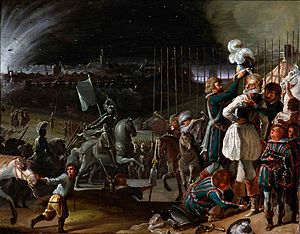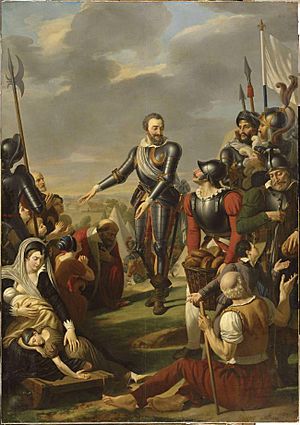Siege of Paris (1590) facts for kids
Quick facts for kids Siege of Paris |
|||||||
|---|---|---|---|---|---|---|---|
| Part of the French Wars of Religion | |||||||
 |
|||||||
|
|||||||
| Belligerents | |||||||
|
|
|||||||
| Commanders and leaders | |||||||
| Strength | |||||||
| 12,000 rising to 25,000 | Approx. 30,000–50,000 (defenders and relief army) | ||||||
The Siege of Paris happened from May 7 to August 30, 1590. It was a major event during the French Wars of Religion, which were a series of conflicts between Catholics and Protestants in France. During this siege, King Henry IV and his army tried to take control of Paris. His army included French Protestants, known as Huguenots. However, they could not capture the city from the Catholic League. Paris was eventually saved when a combined Catholic and Spanish army arrived, led by Alexander Farnese, Duke of Parma.
Contents
Why Paris Was Attacked
The Fight for the French Throne
After a big win at the Battle of Ivry on March 14, Henry of Navarre (who would become King Henry IV) moved his troops toward Paris. He wanted to take Paris because controlling the capital city would help him become the recognized King of France. At this time, many people did not accept him as king because he was a Protestant. Paris was a very large city, with about 200,000 to 220,000 people living inside its walls.
The Siege Begins
Surrounding the City
On May 7, Henry's army completely surrounded Paris. They blocked all ways in and out of the city. To stop food from reaching the people inside, Henry's soldiers even burned down windmills nearby. These windmills were used to grind grain into flour, which was a main food source.
Who Was Fighting?
At the start, Henry had about 12,000 to 13,000 soldiers. The city of Paris, however, had many more defenders, estimated at around 30,000. Most of these defenders were local citizens who had formed a militia. Henry did not have many large cannons for attacking city walls. Because of this, he planned to force Paris to give up by starving the people inside. The city's defense was led by a young man named Charles Emmanuel, Duke of Nemours.
Bombarding Paris
Henry set up his cannons on the hills of Montmartre, which gave him a good view of the city. From there, his army fired cannonballs into Paris. In July, Henry's army grew stronger when more soldiers joined him, bringing his total force to 25,000. By August, his troops had taken over all the areas just outside the city walls. Henry tried to talk to the people of Paris and get them to surrender. But they refused his offer, and the siege continued.
Help Arrives for Paris
On August 30, good news reached the people trapped in Paris. A Spanish and Catholic army, led by the Duke of Parma, was on its way to help them. This relief army successfully broke through Henry's blockade and brought much-needed food supplies into the city. After one last attempt to attack the city's defenses failed, Henry decided to end the siege. He pulled his army back on September 9. Sadly, between 40,000 and 50,000 people in Paris died during the siege, mostly from starvation.
What Happened Next
Henry IV Becomes King
After trying and failing several times to capture Paris, Henry IV made a big decision. In 1593, he converted to Catholicism. He is famously quoted as saying, "Paris is well worth a mass." This meant that becoming Catholic was worth it if it meant he could finally rule France from its capital.
Peace for France
The people of Paris were tired of the war. They turned against the hardline members of the Catholic League who wanted to keep fighting even after Henry became Catholic. In 1594, Paris joyfully welcomed Henry, who had once been a Protestant. He was crowned King of France that same year. Four years later, he issued the Edict of Nantes. This important document aimed to bring an end to the religious conflicts that had divided France for so long.


